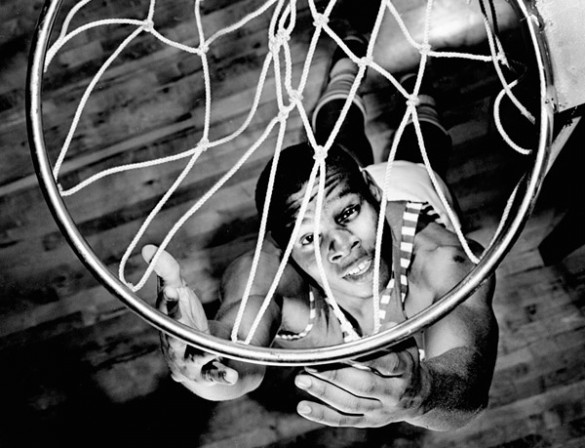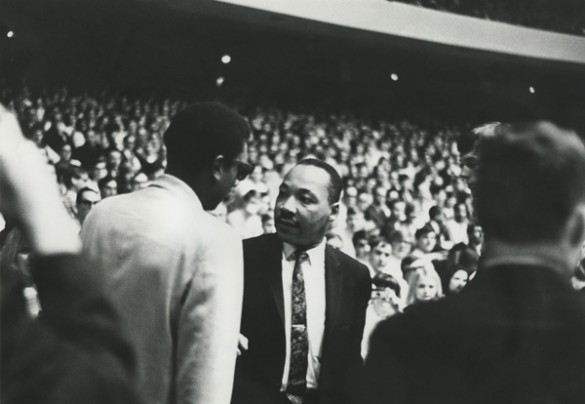
The Vanderbilt University Fine Arts Gallery presents “Race, Sports and Vanderbilt: 1966–1970,” which will showcase photographs, front pages from The Tennessean, and related artifacts from this time period, beginning Friday, Sept. 23. The exhibition is curated by Martin Rapisarda, associate dean of the College of Arts and Science, and is the gallery’s fifth consecutive collaboration with the Commons Reading, which for 2016 is Strong Inside: Perry Wallace and the Collision of Race and Sports in the South by Andrew Maraniss.
An opening reception will take place Sept. 23 from 5 to 8 p.m. in conjunction with Fall for the Arts and Parents’ Weekend. At 6 p.m. Sept. 23, a panel discussion moderated by Rapisarda will feature Maraniss, along with Vice Chancellor for Athletics David Williams and Vice Chancellor for Equity, Diversity and Inclusion Dr. George C. Hill. The reception and exhibition are free and open to the public. The exhibition will be on view through Dec. 8, 2016.
The Fine Arts Gallery is located in Cohen Memorial Hall, 1220 21st Ave. S., on the western edge of the Peabody College campus. Gallery hours are Monday through Friday, 11 a.m.–4 p.m.; and Saturday and Sunday, 1–5 p.m. Please note that the gallery will be closed Oct. 13–16 for Fall Break and Nov. 19–27 for Thanksgiving Break.
“Race, Sports and Vanderbilt: 1966–1970” seeks to answer the question “How does today’s Vanderbilt differ from the Vanderbilt of 50 years ago, and in what ways is it the same?” With a specific focus on race and sports, the exhibition helps visitors explore these questions in order to illuminate the turbulent 1960s, which was characterized by contradictions and conflict. Central to the exhibition is the story of Perry Wallace, a Nashville native who had been the valedictorian at Pearl High School. Maraniss writes that “impressed with Vanderbilt’s engineering department … he chose Vanderbilt in spite of the fact he would be the SEC’s first black player, not because of it.”

Using Strong Inside and the story of Wallace as its starting point, the exhibition examines the wider context of many issues with which Vanderbilt in particular, and the country as a whole, were struggling. The 1967 Commodore yearbook included a section titled “The Year Vandy Woke Up.” Rapisarda, the exhibition curator, observed that “the late ’60s was the period Vanderbilt began to wake up, spurred in large part by Chancellor Alexander Heard’s leadership in promoting the increased integration of the university and the student body’s engagement with current issues through the Impact Symposium series.” The Impact Symposium series at Vanderbilt began in 1964, when a group of students saw the need to increase the campus’s exposure to current issues by providing a forum in which intellectually challenging—and sometimes controversial—speakers could be heard.
These years saw the first African American basketball players at Vanderbilt and in the SEC. It also was when Levi Watkins Jr. became the first African American to enter the Vanderbilt School of Medicine. In 1967, Walter R. Murray founded the Afro-American Association, and in 1970 he became the university’s first African American on the Board of Trust. Soon after, Bishop Joseph A. Johnson, the first African American to be admitted to Vanderbilt (in 1953) and the first African American to earn a doctorate at Vanderbilt (1958), became the second African American to serve on the Board of Trust. But, as Maraniss’ book describes in detail, these and many other developments did not occur easily or without a price. For many on campus at that time, they had to be strong outside as well as strong inside.
Included in the exhibition are the following:
- Historical photographs from Vanderbilt University Special Collections, Vanderbilt Athletics, the Nashville Banner, and The Tennessean
- Select front pages of The Tennessean from 1966–1970
- Oral history video interviews and video clips of speeches made at Impact Symposia, including one by Martin Luther King Jr.
- Vanderbilt publications from the era, including The Commodore yearbook, co-ed handbook, and Impact Symposium magazines
- A basketball rim torn down as the result of repeated slam dunks at the state championship game won by Pearl High School when Wallace was on the team
“Race, Sports and Vanderbilt: 1966–1970” is co-sponsored by Vanderbilt Athletics, the Office of Equity, Diversity and Inclusion, Vanderbilt University School of Medicine, the College of Arts and Science, and The Martha Rivers Ingram Commons.
Exhibition materials and advice have been provided by Andrew Maraniss; Rosevelt Noble, senior lecturer in sociology; David Williams; Rod Williamson of Vanderbilt Athletics; Dr. George C. Hill; Dr. André Churchwell; Teresa Gray of Vanderbilt University Library Special Collections; Beth Odle of the Nashville Public Library; The Tennessean; and the Bishop Joseph Johnson Black Cultural Center at Vanderbilt.
Contact: Joseph Mella, 615-343-1704
joseph.mella@vanderbilt.edu